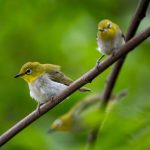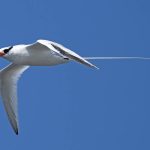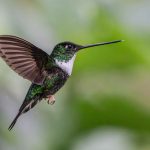This post was originally published on September 25, 2010. It is republished in our new “From the Archives” series, by which we want to draw attention to our vast back catalogue of more than 10,000 birding-related posts published over the last 15 years or so.
Several times over the last couple of years I have had non-birder acquaintances ask me about the “bird with polka dots,” “a bird on my lawn with polka dots,” or “the polka dot bird.” In Golden Wings, an anthology of birding tales by Pete Dunne, one of his stories is called “A Flicker Day for Sure” and he captures what happens to birders all over on the autumn days when the polka dot birds move:

…I picked it up on the fifth ring.
‘It’s a flicker,’ I chanted into the mouthpiece.
‘What?’ a somewhat startled voice inquired.
‘It’s a flicker,’ I repeated, in my most cheerful voice.
‘There was a moment’s stunned silence, then a cautious inquiry. ‘Is this the Audubon Society?’
‘Yes ma’am,’ I replied.
‘Oh, good, maybe you can help me. There’s a strange bird sitting on our lawn that’s all brown with black spots and…’
No doubt about it. A flicker day for sure.
Dunne is, of course, referring to the Northern Flicker Colaptes auratus, or, to be more (sub) specific because he is an east coast birder, the Yellow-shafted Flicker. You see, at one time there were two flickers, one with yellow underwings and one  with red underwings and each was considered its own species.* Those days are gone now, as the lumpers won that skirmish back in the 1970s, and we are stuck with the less poetic, but perhaps more accurate, Northern Flicker.
with red underwings and each was considered its own species.* Those days are gone now, as the lumpers won that skirmish back in the 1970s, and we are stuck with the less poetic, but perhaps more accurate, Northern Flicker.
But, wait, what the heck is a flicker? A flicker is a woodpecker, but a bizarre kind of woodpecker. One will rarely see a Northern Flicker doing that most famous of woodpecker activities, that is, bashing its head into a tree (they do drum, as most woodpeckers do, as a replacement for song, but tend not to drill for food in trees). No, flickers are more genteel, and are prone to picnics. Seriously, they sit on lawns and eat what they find there, often turning the tables, so to speak, on ants, by eating the little insects on their flicker picnics. They have long barbed tongues that are ideal for snaking into anthills and lapping up ants.
Flickers are also odd in the woodpecker world, but not unique, in that they are migratory, and it is in the fall, when flocks of flickers sometimes show up, that befuddled homeowners start trying to find out what the heck is on their lawn. It was on a bright, sunny, fall day that I got these images at Kissena Park in Queens, NY. Flocks of flickers were foraging in the area and, for once, they allowed me a close enough approach that I could get some decent pictures. I hope you like these flicker shots as much as flickers like ants!
…
*There are other differences as well. Red-shafted Flickers have a mostly-gray face, while Yellow-shafted Flickers have a brown face. Male red-shafts sport a red malar stripe while the male yellow-shafts have a black one. Both genders of the Red-shafted Flicker lack the red crescent on the back of the head.
















Leave a Comment